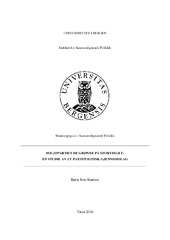Miljøpartiet de Grønne på Stortinget: En studie av et partipolitisk gjennomslag
Abstract
The aim of this study is to explain the entrance of the Norwegian Green Party in national politics in Norway. Even if the environmental issue has been strongly present in Norwegian politics, a green party represented in the Parliament has been absent. The general election of 2013 marked a political breakthrough when Rasmus Hansson was elected Member of Parliament, as the first in the history of the party. This thesis attempts to identify key factors enabling the Norwegian Green Party's position at the general election in 2013. By applying relevant literature studying previous green parties, and their emergence in political landscapes, five theoretical expectations of what facilitated the political possibilities for the Norwegian Green Party in 2013, was presented. By applying a case study including qualitative interviewing, document analysis and analysis of secondary data, these expectations was tested by looking at internal organizational variables and other factors like voters' attitude toward the environmental issue, changes in issue ownership and the medias influence on the party's success in 2013. Professionalization of the Green Party's organization, leadership efforts, changes in the political ownership of the environmental issue and media attention, was identified as key components in explaining what created the political possibilities for the Norwegian Green Party in the election in 2013. These findings emphasize how inner and outer components of a party can be of importance, and contribute to explain how new parties make their entrance into political systems.
